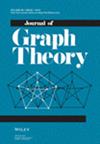下载PDF
{"title":"双向厄尔多斯-京法斯函数的增长率","authors":"Xihe Li, Hajo Broersma, Ligong Wang","doi":"10.1002/jgt.23149","DOIUrl":null,"url":null,"abstract":"<p>Given two graphs <span></span><math>\n <semantics>\n <mrow>\n \n <mrow>\n <mi>G</mi>\n \n <mo>,</mo>\n \n <mi>H</mi>\n </mrow>\n </mrow>\n <annotation> $G,H$</annotation>\n </semantics></math> and a positive integer <span></span><math>\n <semantics>\n <mrow>\n \n <mrow>\n <mi>q</mi>\n </mrow>\n </mrow>\n <annotation> $q$</annotation>\n </semantics></math>, an <span></span><math>\n <semantics>\n <mrow>\n \n <mrow>\n <mrow>\n <mo>(</mo>\n \n <mrow>\n <mi>H</mi>\n \n <mo>,</mo>\n \n <mi>q</mi>\n </mrow>\n \n <mo>)</mo>\n </mrow>\n </mrow>\n </mrow>\n <annotation> $(H,q)$</annotation>\n </semantics></math>-coloring of <span></span><math>\n <semantics>\n <mrow>\n \n <mrow>\n <mi>G</mi>\n </mrow>\n </mrow>\n <annotation> $G$</annotation>\n </semantics></math> is an edge-coloring of <span></span><math>\n <semantics>\n <mrow>\n \n <mrow>\n <mi>G</mi>\n </mrow>\n </mrow>\n <annotation> $G$</annotation>\n </semantics></math> such that every copy of <span></span><math>\n <semantics>\n <mrow>\n \n <mrow>\n <mi>H</mi>\n </mrow>\n </mrow>\n <annotation> $H$</annotation>\n </semantics></math> in <span></span><math>\n <semantics>\n <mrow>\n \n <mrow>\n <mi>G</mi>\n </mrow>\n </mrow>\n <annotation> $G$</annotation>\n </semantics></math> receives at least <span></span><math>\n <semantics>\n <mrow>\n \n <mrow>\n <mi>q</mi>\n </mrow>\n </mrow>\n <annotation> $q$</annotation>\n </semantics></math> distinct colors. The bipartite Erdős–Gyárfás function <span></span><math>\n <semantics>\n <mrow>\n \n <mrow>\n <mi>r</mi>\n \n <mrow>\n <mo>(</mo>\n \n <mrow>\n <msub>\n <mi>K</mi>\n \n <mrow>\n <mi>n</mi>\n \n <mo>,</mo>\n \n <mi>n</mi>\n </mrow>\n </msub>\n \n <mo>,</mo>\n \n <msub>\n <mi>K</mi>\n \n <mrow>\n <mi>s</mi>\n \n <mo>,</mo>\n \n <mi>t</mi>\n </mrow>\n </msub>\n \n <mo>,</mo>\n \n <mi>q</mi>\n </mrow>\n \n <mo>)</mo>\n </mrow>\n </mrow>\n </mrow>\n <annotation> $r({K}_{n,n},{K}_{s,t},q)$</annotation>\n </semantics></math> is defined to be the minimum number of colors needed for <span></span><math>\n <semantics>\n <mrow>\n \n <mrow>\n <msub>\n <mi>K</mi>\n \n <mrow>\n <mi>n</mi>\n \n <mo>,</mo>\n \n <mi>n</mi>\n </mrow>\n </msub>\n </mrow>\n </mrow>\n <annotation> ${K}_{n,n}$</annotation>\n </semantics></math> to have a <span></span><math>\n <semantics>\n <mrow>\n \n <mrow>\n <mrow>\n <mo>(</mo>\n \n <mrow>\n <msub>\n <mi>K</mi>\n \n <mrow>\n <mi>s</mi>\n \n <mo>,</mo>\n \n <mi>t</mi>\n </mrow>\n </msub>\n \n <mo>,</mo>\n \n <mi>q</mi>\n </mrow>\n \n <mo>)</mo>\n </mrow>\n </mrow>\n </mrow>\n <annotation> $({K}_{s,t},q)$</annotation>\n </semantics></math>-coloring. For balanced complete bipartite graphs <span></span><math>\n <semantics>\n <mrow>\n \n <mrow>\n <msub>\n <mi>K</mi>\n \n <mrow>\n <mi>p</mi>\n \n <mo>,</mo>\n \n <mi>p</mi>\n </mrow>\n </msub>\n </mrow>\n </mrow>\n <annotation> ${K}_{p,p}$</annotation>\n </semantics></math>, the function <span></span><math>\n <semantics>\n <mrow>\n \n <mrow>\n <mi>r</mi>\n \n <mrow>\n <mo>(</mo>\n \n <mrow>\n <msub>\n <mi>K</mi>\n \n <mrow>\n <mi>n</mi>\n \n <mo>,</mo>\n \n <mi>n</mi>\n </mrow>\n </msub>\n \n <mo>,</mo>\n \n <msub>\n <mi>K</mi>\n \n <mrow>\n <mi>p</mi>\n \n <mo>,</mo>\n \n <mi>p</mi>\n </mrow>\n </msub>\n \n <mo>,</mo>\n \n <mi>q</mi>\n </mrow>\n \n <mo>)</mo>\n </mrow>\n </mrow>\n </mrow>\n <annotation> $r({K}_{n,n},{K}_{p,p},q)$</annotation>\n </semantics></math> was studied systematically in Axenovich et al. In this paper, we study the asymptotic behavior of this function for complete bipartite graphs <span></span><math>\n <semantics>\n <mrow>\n \n <mrow>\n <msub>\n <mi>K</mi>\n \n <mrow>\n <mi>s</mi>\n \n <mo>,</mo>\n \n <mi>t</mi>\n </mrow>\n </msub>\n </mrow>\n </mrow>\n <annotation> ${K}_{s,t}$</annotation>\n </semantics></math> that are not necessarily balanced. Our main results deal with thresholds and lower and upper bounds for the growth rate of this function, in particular for (sub)linear and (sub)quadratic growth. We also obtain new lower bounds for the balanced bipartite case, and improve several results given by Axenovich, Füredi and Mubayi. Our proof techniques are based on an extension to bipartite graphs of the recently developed Color Energy Method by Pohoata and Sheffer and its refinements, and a generalization of an old result due to Corrádi.</p>","PeriodicalId":16014,"journal":{"name":"Journal of Graph Theory","volume":"107 3","pages":"597-628"},"PeriodicalIF":0.9000,"publicationDate":"2024-07-11","publicationTypes":"Journal Article","fieldsOfStudy":null,"isOpenAccess":false,"openAccessPdf":"https://onlinelibrary.wiley.com/doi/epdf/10.1002/jgt.23149","citationCount":"0","resultStr":"{\"title\":\"Growth rates of the bipartite Erdős–Gyárfás function\",\"authors\":\"Xihe Li, Hajo Broersma, Ligong Wang\",\"doi\":\"10.1002/jgt.23149\",\"DOIUrl\":null,\"url\":null,\"abstract\":\"<p>Given two graphs <span></span><math>\\n <semantics>\\n <mrow>\\n \\n <mrow>\\n <mi>G</mi>\\n \\n <mo>,</mo>\\n \\n <mi>H</mi>\\n </mrow>\\n </mrow>\\n <annotation> $G,H$</annotation>\\n </semantics></math> and a positive integer <span></span><math>\\n <semantics>\\n <mrow>\\n \\n <mrow>\\n <mi>q</mi>\\n </mrow>\\n </mrow>\\n <annotation> $q$</annotation>\\n </semantics></math>, an <span></span><math>\\n <semantics>\\n <mrow>\\n \\n <mrow>\\n <mrow>\\n <mo>(</mo>\\n \\n <mrow>\\n <mi>H</mi>\\n \\n <mo>,</mo>\\n \\n <mi>q</mi>\\n </mrow>\\n \\n <mo>)</mo>\\n </mrow>\\n </mrow>\\n </mrow>\\n <annotation> $(H,q)$</annotation>\\n </semantics></math>-coloring of <span></span><math>\\n <semantics>\\n <mrow>\\n \\n <mrow>\\n <mi>G</mi>\\n </mrow>\\n </mrow>\\n <annotation> $G$</annotation>\\n </semantics></math> is an edge-coloring of <span></span><math>\\n <semantics>\\n <mrow>\\n \\n <mrow>\\n <mi>G</mi>\\n </mrow>\\n </mrow>\\n <annotation> $G$</annotation>\\n </semantics></math> such that every copy of <span></span><math>\\n <semantics>\\n <mrow>\\n \\n <mrow>\\n <mi>H</mi>\\n </mrow>\\n </mrow>\\n <annotation> $H$</annotation>\\n </semantics></math> in <span></span><math>\\n <semantics>\\n <mrow>\\n \\n <mrow>\\n <mi>G</mi>\\n </mrow>\\n </mrow>\\n <annotation> $G$</annotation>\\n </semantics></math> receives at least <span></span><math>\\n <semantics>\\n <mrow>\\n \\n <mrow>\\n <mi>q</mi>\\n </mrow>\\n </mrow>\\n <annotation> $q$</annotation>\\n </semantics></math> distinct colors. The bipartite Erdős–Gyárfás function <span></span><math>\\n <semantics>\\n <mrow>\\n \\n <mrow>\\n <mi>r</mi>\\n \\n <mrow>\\n <mo>(</mo>\\n \\n <mrow>\\n <msub>\\n <mi>K</mi>\\n \\n <mrow>\\n <mi>n</mi>\\n \\n <mo>,</mo>\\n \\n <mi>n</mi>\\n </mrow>\\n </msub>\\n \\n <mo>,</mo>\\n \\n <msub>\\n <mi>K</mi>\\n \\n <mrow>\\n <mi>s</mi>\\n \\n <mo>,</mo>\\n \\n <mi>t</mi>\\n </mrow>\\n </msub>\\n \\n <mo>,</mo>\\n \\n <mi>q</mi>\\n </mrow>\\n \\n <mo>)</mo>\\n </mrow>\\n </mrow>\\n </mrow>\\n <annotation> $r({K}_{n,n},{K}_{s,t},q)$</annotation>\\n </semantics></math> is defined to be the minimum number of colors needed for <span></span><math>\\n <semantics>\\n <mrow>\\n \\n <mrow>\\n <msub>\\n <mi>K</mi>\\n \\n <mrow>\\n <mi>n</mi>\\n \\n <mo>,</mo>\\n \\n <mi>n</mi>\\n </mrow>\\n </msub>\\n </mrow>\\n </mrow>\\n <annotation> ${K}_{n,n}$</annotation>\\n </semantics></math> to have a <span></span><math>\\n <semantics>\\n <mrow>\\n \\n <mrow>\\n <mrow>\\n <mo>(</mo>\\n \\n <mrow>\\n <msub>\\n <mi>K</mi>\\n \\n <mrow>\\n <mi>s</mi>\\n \\n <mo>,</mo>\\n \\n <mi>t</mi>\\n </mrow>\\n </msub>\\n \\n <mo>,</mo>\\n \\n <mi>q</mi>\\n </mrow>\\n \\n <mo>)</mo>\\n </mrow>\\n </mrow>\\n </mrow>\\n <annotation> $({K}_{s,t},q)$</annotation>\\n </semantics></math>-coloring. For balanced complete bipartite graphs <span></span><math>\\n <semantics>\\n <mrow>\\n \\n <mrow>\\n <msub>\\n <mi>K</mi>\\n \\n <mrow>\\n <mi>p</mi>\\n \\n <mo>,</mo>\\n \\n <mi>p</mi>\\n </mrow>\\n </msub>\\n </mrow>\\n </mrow>\\n <annotation> ${K}_{p,p}$</annotation>\\n </semantics></math>, the function <span></span><math>\\n <semantics>\\n <mrow>\\n \\n <mrow>\\n <mi>r</mi>\\n \\n <mrow>\\n <mo>(</mo>\\n \\n <mrow>\\n <msub>\\n <mi>K</mi>\\n \\n <mrow>\\n <mi>n</mi>\\n \\n <mo>,</mo>\\n \\n <mi>n</mi>\\n </mrow>\\n </msub>\\n \\n <mo>,</mo>\\n \\n <msub>\\n <mi>K</mi>\\n \\n <mrow>\\n <mi>p</mi>\\n \\n <mo>,</mo>\\n \\n <mi>p</mi>\\n </mrow>\\n </msub>\\n \\n <mo>,</mo>\\n \\n <mi>q</mi>\\n </mrow>\\n \\n <mo>)</mo>\\n </mrow>\\n </mrow>\\n </mrow>\\n <annotation> $r({K}_{n,n},{K}_{p,p},q)$</annotation>\\n </semantics></math> was studied systematically in Axenovich et al. In this paper, we study the asymptotic behavior of this function for complete bipartite graphs <span></span><math>\\n <semantics>\\n <mrow>\\n \\n <mrow>\\n <msub>\\n <mi>K</mi>\\n \\n <mrow>\\n <mi>s</mi>\\n \\n <mo>,</mo>\\n \\n <mi>t</mi>\\n </mrow>\\n </msub>\\n </mrow>\\n </mrow>\\n <annotation> ${K}_{s,t}$</annotation>\\n </semantics></math> that are not necessarily balanced. Our main results deal with thresholds and lower and upper bounds for the growth rate of this function, in particular for (sub)linear and (sub)quadratic growth. We also obtain new lower bounds for the balanced bipartite case, and improve several results given by Axenovich, Füredi and Mubayi. Our proof techniques are based on an extension to bipartite graphs of the recently developed Color Energy Method by Pohoata and Sheffer and its refinements, and a generalization of an old result due to Corrádi.</p>\",\"PeriodicalId\":16014,\"journal\":{\"name\":\"Journal of Graph Theory\",\"volume\":\"107 3\",\"pages\":\"597-628\"},\"PeriodicalIF\":0.9000,\"publicationDate\":\"2024-07-11\",\"publicationTypes\":\"Journal Article\",\"fieldsOfStudy\":null,\"isOpenAccess\":false,\"openAccessPdf\":\"https://onlinelibrary.wiley.com/doi/epdf/10.1002/jgt.23149\",\"citationCount\":\"0\",\"resultStr\":null,\"platform\":\"Semanticscholar\",\"paperid\":null,\"PeriodicalName\":\"Journal of Graph Theory\",\"FirstCategoryId\":\"100\",\"ListUrlMain\":\"https://onlinelibrary.wiley.com/doi/10.1002/jgt.23149\",\"RegionNum\":3,\"RegionCategory\":\"数学\",\"ArticlePicture\":[],\"TitleCN\":null,\"AbstractTextCN\":null,\"PMCID\":null,\"EPubDate\":\"\",\"PubModel\":\"\",\"JCR\":\"Q2\",\"JCRName\":\"MATHEMATICS\",\"Score\":null,\"Total\":0}","platform":"Semanticscholar","paperid":null,"PeriodicalName":"Journal of Graph Theory","FirstCategoryId":"100","ListUrlMain":"https://onlinelibrary.wiley.com/doi/10.1002/jgt.23149","RegionNum":3,"RegionCategory":"数学","ArticlePicture":[],"TitleCN":null,"AbstractTextCN":null,"PMCID":null,"EPubDate":"","PubModel":"","JCR":"Q2","JCRName":"MATHEMATICS","Score":null,"Total":0}
引用次数: 0
引用
批量引用




 求助内容:
求助内容: 应助结果提醒方式:
应助结果提醒方式:
